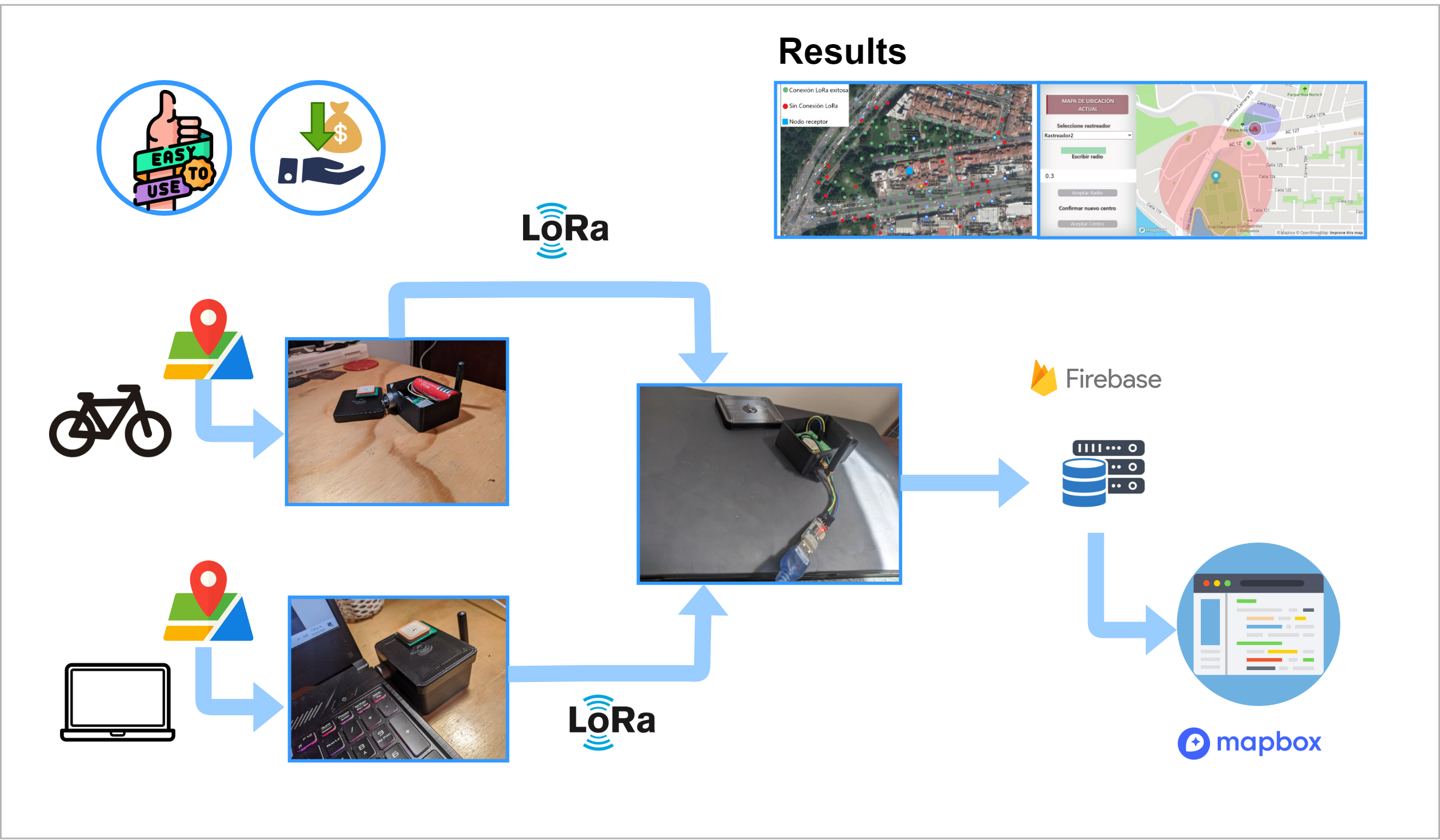Design and Implementation of a Cost-Effective Object Tracking System Based on LoRa, Firebase, and Mapbox
Keywords:
Web services, Databases, Open source software, Global Positioning System, Wide area networks, Wireless sensor networksAbstract
This paper describes the design and implementation of an object tracking system based on LoRa®, Firebase®, and
Mapbox®. The proposed system allows real-time visualization of the tracking nodes in a web interface following a low-cost and low-complexity design approach. The cost of each tracking node and the gateway were USD $39.38 and USD $28.00, respectively. Regarding its performance, the energy autonomy of each tracking node was 270.6 hours with maximum coverture of 896 meters under open field conditions, which is hard reduced to 114 meters under indoor conditions.
Downloads
References
R. Priyadarshi, B. Gupta, and A. Anurag, “Deployment techniques in
wireless sensor networks: a survey, classification, challenges, and future
research issues,” J. Supercomput., Jan. 2020.
F. Giménez, C. Zerbini and G. Riva, .Extending SMS Service Coverage
in Rural Areas by using LoRa Communication Technology,ïn IEEE Latin
America Transactions, vol. 18, no. 02, pp. 214-222, February 2020, doi:
1109/TLA.2020.9085273.
P. Lai, H. Huang, M. Sheu, C. Wu, J. Le, and T. Chen, “Bike Sensor System
Design for Safety and Healthy Riding,” in 2018 IEEE International
Conf. Consum. Electron. Taiwan (ICCE-TW), 2018, pp. 1–2, 1.
D. H. Kim, J. B. Park, J. H. Shin, and J. D. Kim, “Design and
implementation of object tracking system based on LoRa,” in 2017 Int.
Conf. on Inform. Netw. (ICOIN), 2017, pp. 463–467.
R. Osorio Comparan, D. Vasquez, I. Lopez Juarez, M. Pena, J. Savage
and G. Lefranc, "System Administration and Monitoring Moving Objects
Using Mobile Devices,ïn IEEE Latin America Transactions, vol. 13, no.
, pp. 1934-1939, June 2015, doi: 10.1109/TLA.2015.7164220.
S.-Y. Wang et al., Performance of LoRa-Based IoT Applications on
Campus. 2017.
G. Lian and F. Yu, “A data platform based on web service for wireless
sensor network,” in 2014 4th IEEE Int. Conf. on Inform. Sci. and
Technol., 2014, pp. 670–673.
T. Arai, T. Yoshizawa, T. Aoki, K. Zempo, and Y. Okada, “Evaluation of
Indoor Positioning System based on Attachable Infrared Beacons in Metal
Shelf Environment,” in 2019 IEEE International Conference on Consumer
Electronics (ICCE), 2019, pp. 1–4, doi: 10.1109/ICCE.2019.8662007.
M. Ochiai, M. Fujii, A. Ito, Y. Watanabe, and H. Hatano, “A study on
indoor position estimation based on fingerprinting using GPS signals,”
in 2014 International Conference on Indoor Positioning and Indoor
Navigation (IPIN), 2014, pp. 727–728, doi: 10.1109/IPIN.2014.7275552.
R. I. S. Pereira, S. C. S. Jucá, P. C. M. Carvalho and C. P. Souza,
ÏoT Network and Sensor Signal Conditioning for Meteorological
Data and Photovoltaic Module Temperature Monitoring,ïn IEEE Latin
America Transactions, vol. 17, no. 06, pp. 937-944, June 2019, doi:
1109/TLA.2019.8896816.
A. Zourmand, A. L. K. Hing, C. W. Hung, and M. AbdulRehman, “Internet
of Things (IoT) using LoRa technology,” in 2019 IEEE International
Conference on Automatic Control and Intelligent Systems (I2CACIS),
, pp. 324–330, doi: 10.1109/I2CACIS.2019.8825008.
F. Samie, L. Bauer, and J. Henkel, IoT Technologies for Embedded
Computing: A Survey. 2016.
D. Croce, D. Garlisi, F. Giuliano, A. L. Valvo, S. Mangione, and I.
Tinnirello, “Performance of LoRa for Bike-Sharing Systems,” in 2019
AEIT International Conference of Electrical and Electronic Technologies
for Automotive (AEIT AUTOMOTIVE), 2019, pp. 1–6, doi:
23919/EETA.2019.8804519.
Haxhibeqiri, Jetmir, Karaagac, Abdulkadir, Van den Abeele, Floris ,
Joseph, Wout , Moerman, Ingrid , Hoebeke, Jeroen. (2017). LoRa indoor
coverage and performance in an industrial environment: Case study. 1-8.
1109/ETFA.2017.8247601.
“IEEE Standard for Local and metropolitan area networks–Part 15.4:
Low-Rate Wireless Personal Area Networks (LR-WPANs),” IEEE Std
15.4-2011 (Revision of IEEE Std 802.15.4-2006). pp. 1–314, 2011,
doi: 10.1109/IEEESTD.2011.6012487.
L. R. Prando, E. R. de Lima, L. S. de Moraes, M. B. Hamerschmidt, and
G. Fraindenraich, “Experimental Performance Comparison of Emerging
Low Power Wide Area Networking (LPWAN) Technologies for IoT,” in
IEEE 5th World Forum on Internet of Things (WF-IoT), 2019, pp.
–908, doi: 10.1109/WF-IoT.2019.8767343.
C. Yao Yuguang, Zijun Ma, “LoSee: Long-Range Shared Bike Communication
System Based On LoRaWAN Protocol,” 2018.
W. San-Um, P. Lekbunyasin, M. Kodyoo, W. Wongsuwan, J. Makfak,
and J. Kerdsri, “A long-range low-power wireless sensor network based
on U-LoRa technology for tactical troops tracking systems,” in 2017 Third
Asian Conference on Defence Technology (ACDT), 2017, pp. 32–35, doi:
1109/ACDT.2017.7886152.
datasheet/sx1272.pdf.
Stack Overflow: https://electronics.stackexchange.com/. Ünderstanding
the relationship between LoRa chips, chirps, symbols and bits"
G. Lian and F. Yu, “A data platform based on web service for wireless
sensor network,” in 2014 4th IEEE Int. Conf. on Inform. Sci. and
Technol., 2014, pp. 670–673.
LoRaWAN™ 1.0.3 Regional Parameters -
LoRa Alliance. https://lora-alliance.org/wpcontent/
uploads/2020/11/lorawan_regional_parameters_v1.0.3reva_0.pdf
Microchip Technology Inc. RN2903 LoRa™ Technology Module.
http://ww1.microchip.com/downloads/en/ DeviceDoc/40001811A.pdf
Microchip Technology Inc.2021
https://www.nmea.org/, access: 10.02.2018
Min Chen and G. A. Rincon-Mora, “ Accurate electrical battery model
capable of predicting runtime and I-V performance,” in IEEE Transactions
on Energy Conversion, vol. 21, no. 2, pp. 504-511, June 2006, doi:
1109/TEC.2006.874229.
u-blox NEO-6u-blox 6 GPS Modules DataSheets.
https://www.u-blox.com/sites/default/files/products/documents/NEO-
_DataSheet_(GPS.G6-HW-09005).pdf
Carvajal, J. P. (2021). A low cost web interface for object tracking based
on wireless sensor network [E-book]. In A. Fajardo C. Páez Rueda (Eds.),
Advanced Computing and Intelligent Technologies (ch. 32). Springer.


